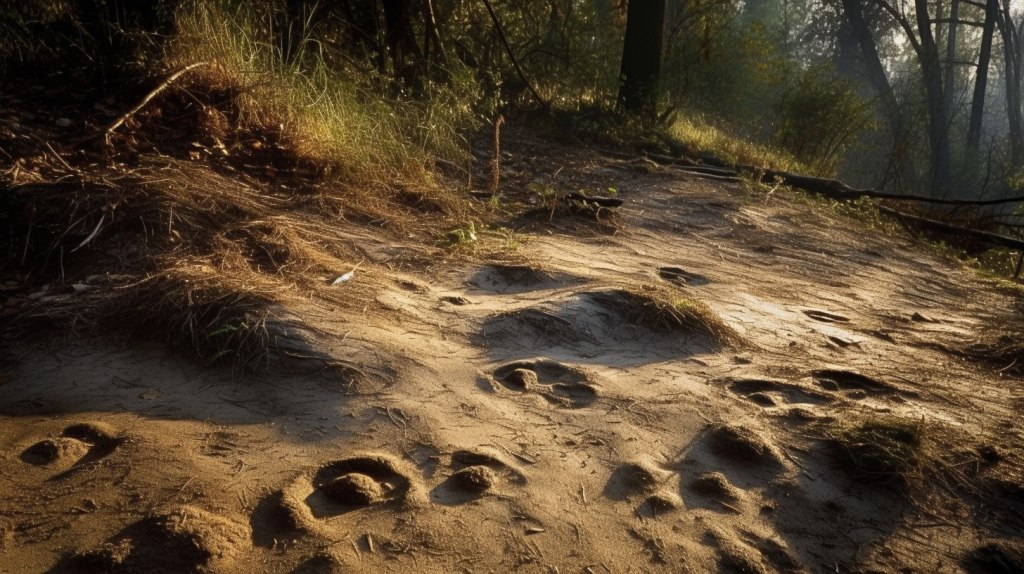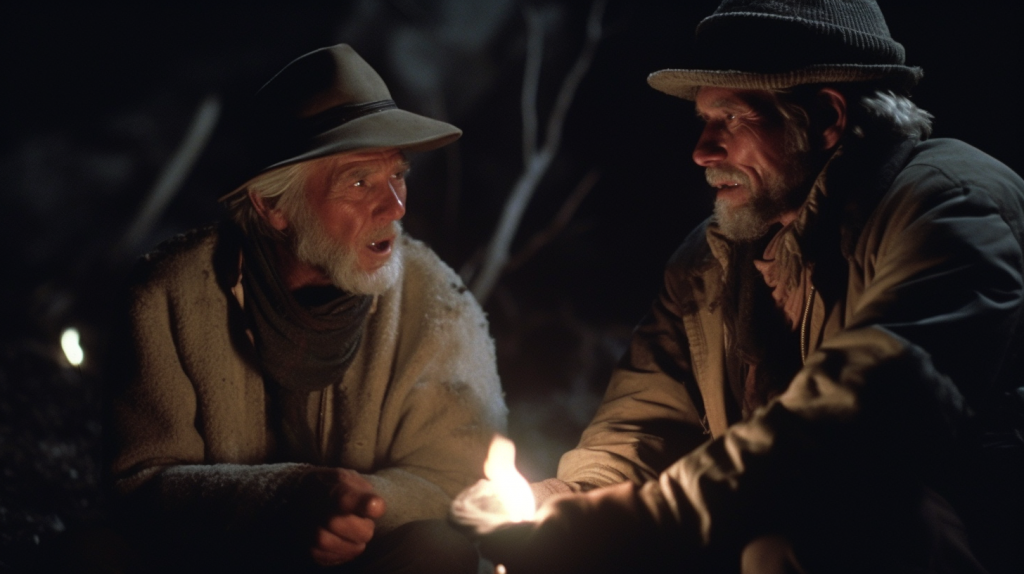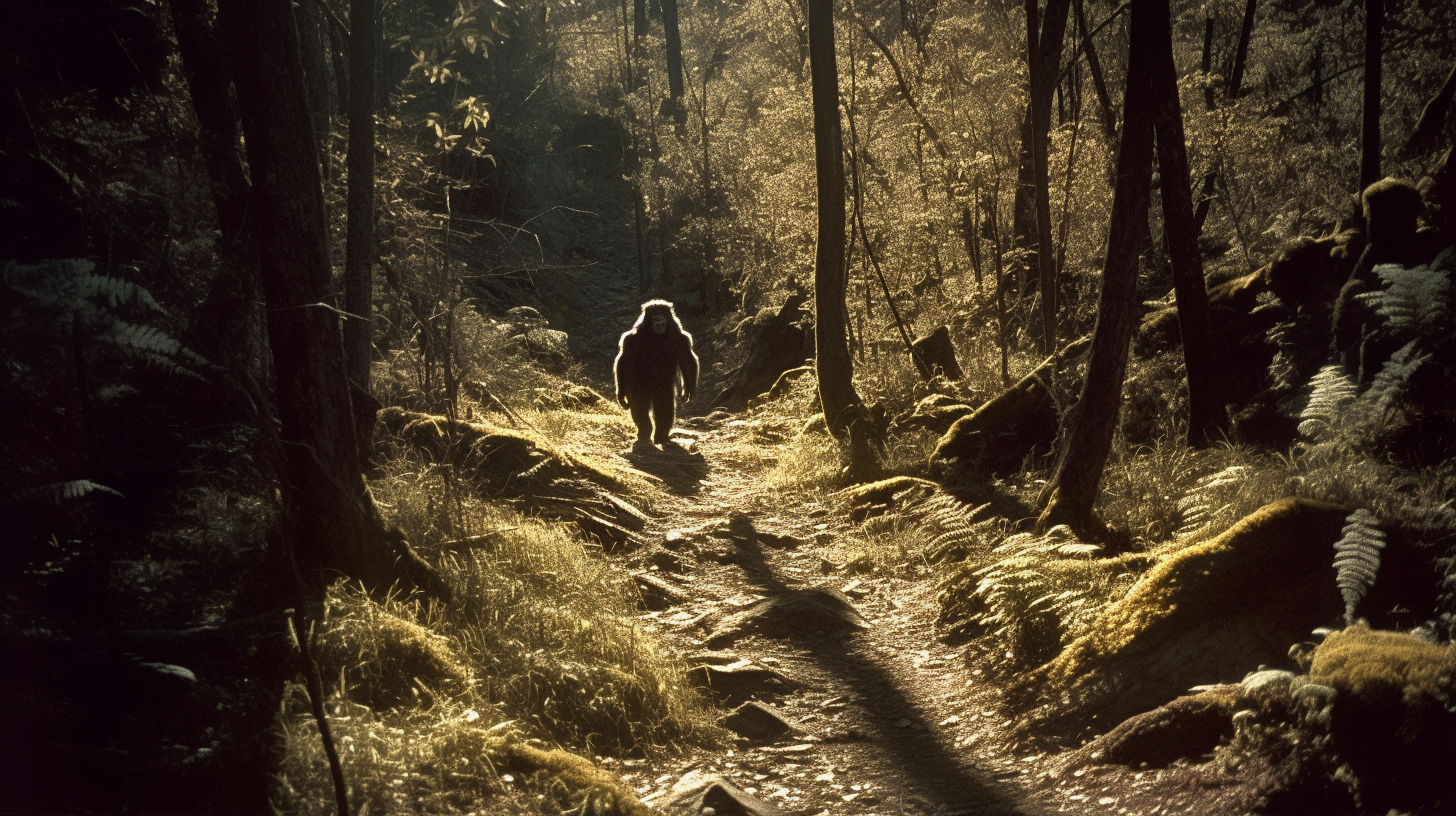One quiet afternoon in October 1967, two cowboys, Roger Patterson and Bob Gimlin, rode into Bluff Creek, California. Little did they know, the grainy, 59.5-second film they shot that day would become the most iconic piece of evidence in Bigfoot lore. Despite numerous attempts to debunk it, the Patterson-Gimlin Film remains a vital artifact in the search for this elusive creature.
The Encounter and the Film
Patterson and Gimlin were riding south along Bluff Creek’s eastern bank when they spotted a large, hairy figure on the opposite side. The creature, startled by their presence, rose and walked away, but not before Patterson captured it on film. The film shows what appears to be a large, bipedal creature covered in dark fur, walking with a peculiar gait.
The entire encounter lasted less than two minutes, but the impact of those few moments has echoed down through the decades. Patterson, who was riding a little ahead of Gimlin, saw the creature first. He later described it as being hunched over before it quickly stood up upon their arrival. Startled, Patterson’s horse reared, and he spent precious seconds regaining control and retrieving his camera from his saddlebag.
As Patterson struggled with his horse, Gimlin maintained a defensive position, ready to protect his friend if the creature turned hostile. He kept his hand near the rifle he carried, but the creature showed no signs of aggression. It simply continued its path, glancing towards the men only once. This glance was captured on film, providing a clear view of the creature’s face, which bore a strong resemblance to descriptions given by Bigfoot eyewitnesses: high cheekbones, deep-set eyes, and a crested forehead.

Meanwhile, Patterson, having retrieved his camera, began to run after the creature, trying to steady his hand and the camera as he moved. This is why the first segment of the film is quite shaky. After about 20 seconds, Patterson managed to find a more stable position from a fallen log, resulting in clearer footage for the remainder of the film. He continued filming until the creature disappeared into the dense forest, and the film in his camera ran out.
In the aftermath of the encounter, Patterson and Gimlin were filled with a mixture of excitement and dread. They realized they had filmed something extraordinary, but they also knew that proving it to a skeptical world would be a monumental task. Little did they know that their brief encounter would become one of the most analyzed pieces of film in the history of cryptozoology.
The Aftermath
The film was met with instant fascination and skepticism. Experts were brought in to analyze the footage, and their conclusions varied widely. Some argued that the creature’s movement and proportions could not have been replicated by a human, while others claimed it was an elaborate hoax.
In the wake of the film’s release, Patterson and Gimlin found themselves thrust into an unexpected spotlight. They were approached by a myriad of people, from die-hard Bigfoot believers to hardened skeptics, all with their own agenda. The two men were interviewed extensively, their words dissected and analyzed nearly as much as the film itself. Amidst this whirlwind, they stood firm in their assertion that what they had filmed was real.

The controversy surrounding the film brought about an onslaught of criticism and accusations. Patterson and Gimlin were accused of perpetrating a hoax for financial gain, an accusation they vehemently denied. Despite the controversy and skepticism, the film continued to captivate the public’s imagination. Regardless of one’s belief in its authenticity, the Patterson–Gimlin film remains a powerful symbol in the search for Bigfoot, a testament to our enduring fascination with the unknown.
Debunking Attempts
Over the years, numerous people have claimed to be the man in the Bigfoot suit. Costume designers have also come forward, stating they could easily replicate the creature seen in the film. Despite these claims, no one has been able to reproduce the exact movement and proportions of the creature in the film.
One of the most compelling attempts to debunk the film came from a man named Bob Heironimus, who claimed he was the figure in the suit. Heironimus produced a costume that bore a striking resemblance to the creature in the film, but critics pointed out that the suit lacked the muscle definition and fluid movement observed in the original footage. Moreover, skeptics have scrutinized Heironimus’s claim, pointing out inconsistencies in his story and lack of conclusive evidence. Despite the multitude of debunking attempts, none have definitively disproved the authenticity of the film, leaving the mystery alive.
The Film’s Legacy
While the film’s authenticity remains a point of contention, its cultural impact is undeniable. It has sparked countless Bigfoot hunts and inspired numerous films, TV shows, and documentaries. For many, the Patterson-Gimlin Film is more than just a piece of footage; it’s a symbol of the human fascination with the unknown.
The Patterson-Gimlin Film, whether a hoax or genuine evidence of an undiscovered creature, undoubtedly injected a dose of visceral reality into the Bigfoot legend. It has served as a cornerstone for cryptid enthusiasts, encouraging a new generation of investigators and explorers to delve into the mystery of Bigfoot. The film’s grainy image of a lumbering, hairy figure has become iconic, a familiar reference point in popular culture. Despite the passage of time, the intrigue surrounding the film has not faded, but rather has been rekindled with advancements in film analysis technology. The legacy of the Patterson-Gimlin film is not merely in its perpetuation of the Bigfoot legend, but in its enduring challenge to our understanding of what is possible in our world.
Scientific Scrutiny and Debate
The film has been subjected to meticulous scrutiny. Some scientists have analyzed the creature’s gait, arguing that it’s distinctively non-human. Others have focused on its anatomy, suggesting that the creature’s proportions are too different from a human’s to be a hoax.
Enhanced Analyses and Technological Advances
With the advent of new technologies, the Patterson-Gimlin Film has undergone enhanced analyses. Digital remastering and frame-by-frame study have revealed further details that were previously missed in the creature’s anatomy and movement, adding yet another layer to the ongoing debate. Some analyses have focused on the creature’s muscle movement visible beneath the fur, arguing that such detail would be impossible to fake with a costume.
Forensic Analysis and Biomechanics
Some experts have applied principles of forensic science and biomechanics to the creature’s gait in the film. The creature’s walking pattern, often referred to as the ‘compliant gait’, is said to be non-human and would be difficult to replicate convincingly by a person in a suit. Additionally, the creature’s proportion, such as the length of its arms relative to its body, has been argued to be inconsistent with human anatomy. These analyses, though not universally accepted, bring scientific rigor to the discussion and contribute to the film’s enduring intrigue.
The Ongoing Mystery
Despite continuous debate and analysis, the Patterson-Gimlin Film remains an enigma. Is it authentic evidence of an undiscovered creature, or is it one of the most elaborate hoaxes of the 20th century? The film, like the legend of Bigfoot itself, continues to mystify and captivate.
The Patterson-Gimlin Film, with its blurred images and shaky footage, remains an enduring symbol of our fascination with cryptids. As the debate rages on, the film continues to intrigue and captivate, a testament to the power of mystery and the allure of the unknown.




